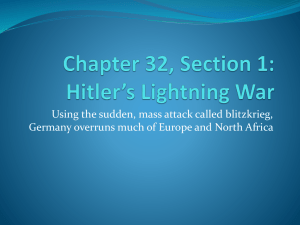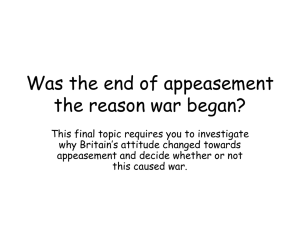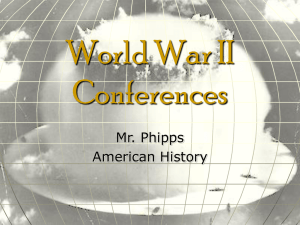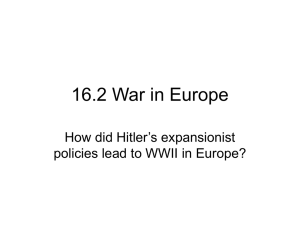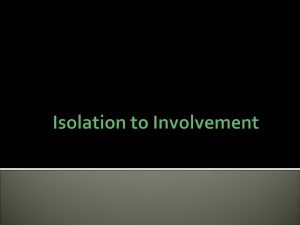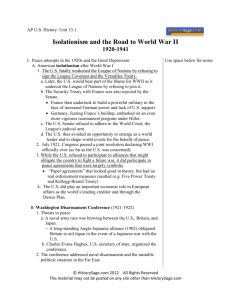Chapter 26A
advertisement
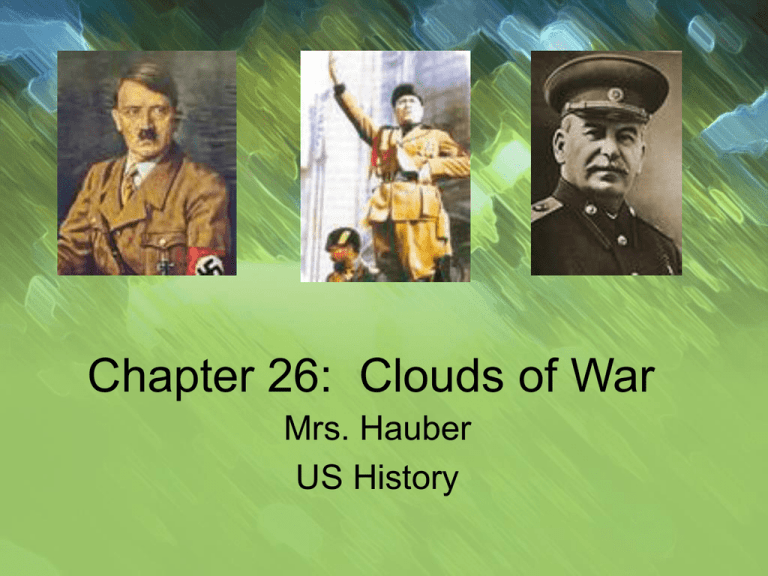
Chapter 26: Clouds of War Mrs. Hauber US History The Rise of Nationalism Rise of Dictators Hitler Mussolini Stalin Austrian Fascist Hated Authority artist Control Media Communist WWI March on Rome “Man of Steel” Jailed Il Duce Mein Kampf Old Roman Empire Helped Lenin in revolution Came to Power when Lenin died NAZI Party Intelligent Great Purge Video Clip on the Causes of WWII Causes of WWII • • • • • • • MAIN Anti-Communism Policy of Appeasement Germany’s occupation of Poland Japan’s invasion of Manchuria and China Italy’s invasion of Ethiopia Stalin’s Non-Aggression Pact Resentment over the Treaty of Versailles • • • • Huge reparations bill to Germany Loss of territories (Alsace-Lorraine) Demilitarization Italy was promised land, but was ignored Development of the Axis Powers • Rome-Berlin Axis—Italy and Germany agree to help fascist forces in the Spanish Civil War. • Anti-COM intern Pact– Japan and Germany agree to help fight Communism (continued) • NAZI-Soviet Pact—(Non Aggression Pact)—Russia and Germany agree to Neutrality – Germany can take Western Poland unopposed – Russia can take Eastern Poland, Finland, Estonia, Latvia, and Lithuania Prior to WWII Hitler's March – Remilitarizes the Rhineland – Annexes Austria unopposed – Germany takes Sudetenland – Munich Pact—(Policy of Appeasement)—Britain and France give into Hitler’s demands of the Sudetenland to ensure peace. Hitler's March (Continued) – 6 months later Germany takes the rest of Czechoslovakia – Germany invades Poland on September 1, 1939 (the start of WWII) Map of Czechoslovakia and Poland Mussolini’s March • Italy invades Ethiopia in Africa • Wants to rebuild Italy into the Old Roman Empire • Forms pact with Germany Japan’s March • Invades Manchuria in 1931 – Japan lacks good resources – Violates Kellogg-Briand pact – US does not risk war • Invades China in 1937 – Declares New World order in Asia – Declares “Open-Door” Policy Closed Japanese Invasion of Manchuria Stalin’s March • Russia fought Finland in a war for one year after pact with Germany • Finns fought bravely and the US admired their bravery. • Finland lost a portion of their land to Russia • Russia took over Baltic Region and Eastern Poland Japanese-American Relations • US did not risk war when Japan invaded Manchuria and China • Panay—US gunboat sunk on the Yangtze River in China by the Japanese. • Japan apologized and paid for damages (didn’t see our flag on ship) The Good Neighbor Policy • FDR’s policy that stresses the respect for other countries in the world by being a “good neighbor” • Originally meant for the whole world • Became our policy toward Latin America • In 1943, US gave up its right to intervene (stated in the Platt Amendment) • First test was in Mexico—US formed a compromise. Quarantine Speech • FDR called for isolation of the aggressor nations • Foreshadows his getting ready for US involvement in the war American Isolationism Neutrality Acts • 1935 & 1936—prohibited the sale of any weapons to warring nations • 1939—Cash & Carry—exception to the neutrality acts whereby warring nations could buy weapons if they paid cash and shipped them from our shores. Section 2: The Battlefield is Everywhere • After Germany’s invasion of Poland, there was no fighting for 6 months despite the fact that Britain and France declared war on Germany • Phony War—nickname given by the press for this time period • Only exception was Soviet Union’s attack on Finland WWII Begins A New Warfare • Blitzkrieg—Hitler’s strategy that overwhelms the enemy with planes, trucks, and tanks. “lightning war” Hitler’s March after Sept 1st • Order in which other countries were invaded: – – – – – – Poland Denmark and Norway Netherlands Belgium Luxemburg France (penetrated the Maginot Line) • Operation Dynamo—300,000 British and French forces evacuated across the English Channel Operation Dynamo Air Power • Billy Mitchell—WWI ace that believed air power was the key to victory in the next war. – In 1921, he demonstrated how using an airplane to drop bombs could sink a battleship Air Power (continued) • Charles Lindbergh—In 1927 he made a famous non-stop flight from NY to Paris • B-17—long-range bomber nicknamed the flying fortress • Admiral William Moffett-- designed the first aircraft carrier and was in charge of the air force US Prepares for War • Plan to turn out 50,000 planes • Create a two-ocean navy • FDR tried to slowly change the nation’s opinion Battle of Britain • Winston Churchill—New Prime Minister that warned that after the surrender of France, Britain would be next. • Mostly fought in the air • Germany launched daylight raids against ports and airfields The London Blitz Battle of Britain (continued) • ULTRA—Germany’s secret codes that Britain intercepted • Sea Lion—Hitler’s planned invasion across the English channel • Hitler postponed this invasion conceding defeat. Election of 1940 • Wendell Wilkie—Republican candidate who was against the New Deal but agreed with FDR in preparing for war. • First peacetime draft ever. (For Defense)— FDR promised “not to send your boys to any foreign wars” • FDR was the 1st President to be elected 3 times. Helping Great Britain • Neutrality Act of 1939 (Cash and Carry)— allowed aid to Britain, France, and China • Destroyers for Bases Deal—US gave Britain 50 old destroyers in exchange for 8 naval bases • Lend-Lease Act—leased war supplies to Britain because they could not afford them. Undeclared Naval War • FDR extends defensive perimeter halfway across the Atlantic Ocean • FDR orders US ships to shoot any German ship within this perimeter on sight. Atlantic Charter • FDR and Churchill meet secretly on a ship outside of Newfoundland • Atlantic Charter—update of Wilson’s 14 points where they came up with a set of “common principles” • FDR spoke of Four Freedoms: speech, religion, want and fear. Warm Up • Explain the undeclared naval war going on in the Atlantic Ocean between the US and Germany. Section 3: War Comes to the US • • • • • Invasion of Russia Submarine Warfare Trouble in the Pacific Attack on Pearl Harbor Declaration of War Hitler Invades Russia • Violates NAZI-Soviet Pact (Operation Barbarossa) • Greatest Blunder because of the climate and vastness of territory • Nazis suffered from frostbite and frozen oil in the motors of their tanks. Germany Increases Submarine Warfare • US was convoying British merchant ships • Three destroyers were hit by German submarines – USS Greer—actually stalking a German submarine; was 1st US ship to be hit. – USS Kearney— 12 Americans were killed – Rueben James—Over 100 killed • Undeclared Naval War Trouble in the Pacific • Greater East Asia Co-Prosperity Sphere—Japanese domination of the Far East • Burma Road—allied supply route to China • Japan wanted US to cut off aid to China Japanese Advancement Trouble in the Pacific (continued) • General Hidecki Tojo—a more warlike General in Japan that came to power • Magic—intelligence the US received from breaking Japan’s codes. Planning the Attack Attack on Pearl Harbor • US government was involved with peace talks with Japan • Decoders knew Japan was going to strike but didn’t know where • Dec. 7, 1941—greatest military disaster in America • 2400 killed Pearl Harbor Declaration of War • Dec 8, 1941—FDR gives his famous “Day of Infamy Speech” to the public. • US declares war on Japan • 3 days later, Germany and Italy declare war on the US
